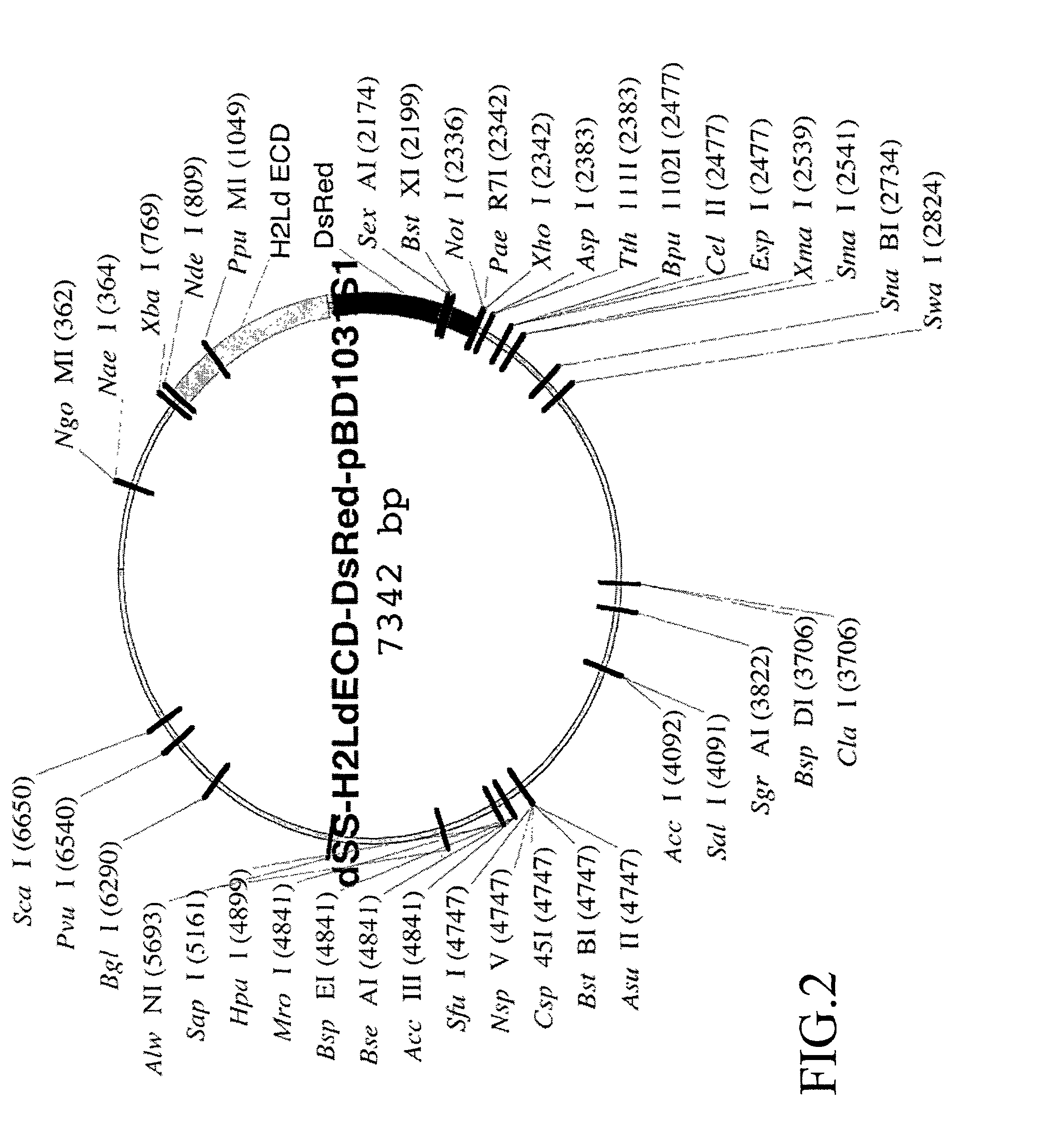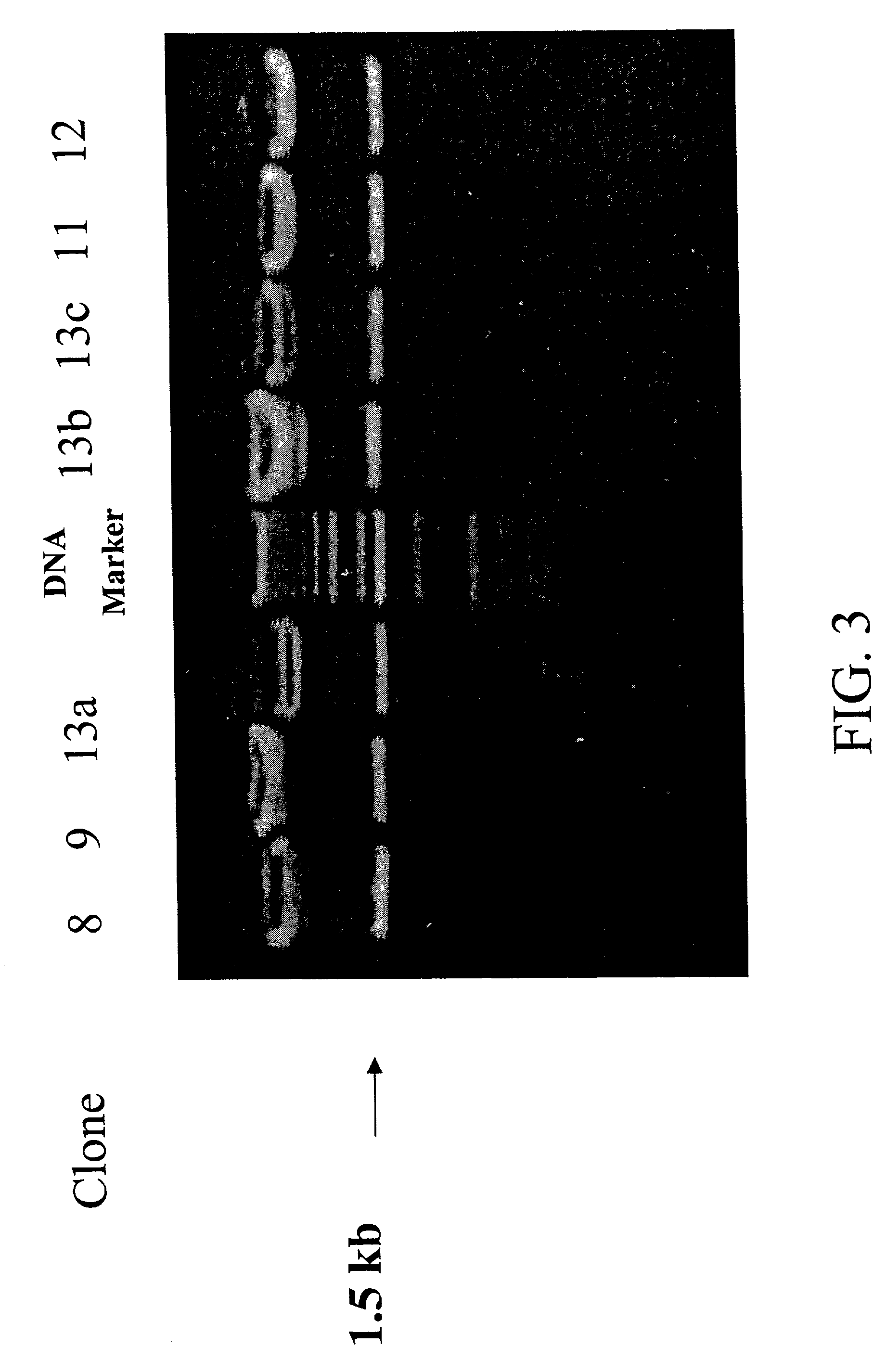Intrinsically fluorescent, self-multimerizing MHC fusion proteins and complexes thereof
a fusion protein and self-multimerizing technology, applied in the field of intra-fluorescence, self-multi-merizing mhc fusion proteins and to complexes thereof, can solve the problems of affecting the yield and utility of the resulting tetramer complex, and reducing the yield of tetramers, so as to achieve sufficient avidity for t lymphocytes and stable binding to surfa
- Summary
- Abstract
- Description
- Claims
- Application Information
AI Technical Summary
Benefits of technology
Problems solved by technology
Method used
Image
Examples
example 1
Construction of an Expression Vector for the Expression of a MHC-DsRed Fusion Protein
[0233]Using standard molecular biology techniques, a DNA sequence encoding the extracellular domain (ECD) of murine H2-Ld MHC class I protein is removed from the H2-Ld CDNA and ligated into the Multiple Cloning Site of the vector pDsRed2-N1 (BD Biosciences-Clontech Cat. #6973-1) digested with the enzymes HindIII and BamHI. This results in an in-frame fusion of the coding sequence of the ECD, oriented at the amino-terminal part of the fusion, with the coding sequence of the DsRed chromophore, oriented at the carboxy-terminal part of the fusion. Construction of the fusion construct is shown schematically in FIG. 1.
[0234]The H2Ld-DsRed2 fusion construct is then ligated into the NdeI and NotI restriction enzyme sites of pBD1031S1, a BD Biosciences-Pharmingen vector developed from PVL1393, Cat. #21201P. The pBD1031S1 vector is a dual expression vector containing a T7 RNA polymerase promoter for expressio...
example 2
Expression of the H2Ld-DsRed Fusion Protein in Bacteria
[0238]Using standard techniques, five clones of the H2Ld-DsRed fusion construct expression vector are used to transform competent E. coli bacteria containing an IPTG inducible T7 RNA polymerase. After growth overnight on ampicillin-LB agar plates, colonies of transformed cells are picked and expanded by growth overnight in LB media. The next day, the overnight culture is further grown at 37° C. in fresh LB media containing IPTG (final concentration 1 mM) for 2 hours.
[0239]Samples of bacteria from induced cultures are then withdrawn and lysed in an SDS-containing buffer, after which the constituent proteins are separated by SDS denaturing polyacrylamide gel electrophoresis (PAGE). After electrophoresis, gels are stained with Coomassie stain, after which the separated, stained proteins are illuminated by visible light and photographed with a video still camera for visual analysis.
[0240]As shown in FIG. 5, for each of five H2Ld-DsR...
example 3
Expression of the H2Ld-DsRed Fusion Protein in Insect Cells
[0242]The H2Ld-DsRed expression vector is cotransfected with BaculoGold™ DNA (BD-Pharmingen, Cat. No. 554739, formerly Cat. No. 21100D) into Sf9 and Tni insect cells using standard techniques discussed in the BD BaculoGold™ Linearized Baculovirus DNA technical data sheet, incorporated herein by reference in its entirety, and available from Pharmingen (BD Bioscience Pharmingen, San Diego, Calif. The expression vector serves as a transfer vector that complements a deletion in the BaculoGold™ virus DNA such that infectious virus is produced that contains within its genome the DNA encoding the H2Ld-DsRed fusion protein. Three days after transfection performed using standard techniques, medium from the transfected cell cultures is collected, cells are removed, and the supernatant is used in the first of three rounds of amplification to obtain a high titer stock solution of infectious baculovirus.
[0243]Using standard techniques, t...
PUM
| Property | Measurement | Unit |
|---|---|---|
| temperatures | aaaaa | aaaaa |
| concentration | aaaaa | aaaaa |
| temperatures | aaaaa | aaaaa |
Abstract
Description
Claims
Application Information
 Login to View More
Login to View More - R&D
- Intellectual Property
- Life Sciences
- Materials
- Tech Scout
- Unparalleled Data Quality
- Higher Quality Content
- 60% Fewer Hallucinations
Browse by: Latest US Patents, China's latest patents, Technical Efficacy Thesaurus, Application Domain, Technology Topic, Popular Technical Reports.
© 2025 PatSnap. All rights reserved.Legal|Privacy policy|Modern Slavery Act Transparency Statement|Sitemap|About US| Contact US: help@patsnap.com



